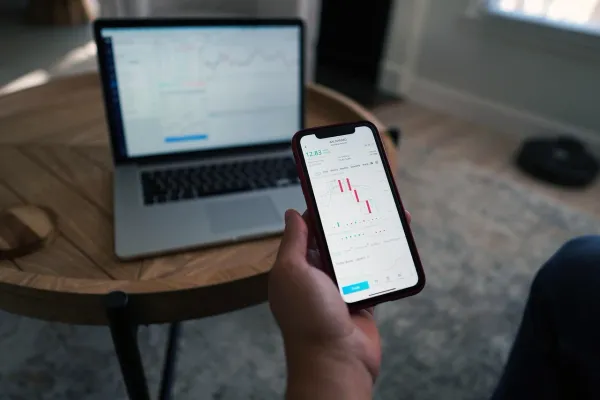What Is Position Trading: Strategy & Key Differences from Swing Trading

Position trading is a long-term strategy for investors who prefer patience over speed. Instead of chasing daily or weekly price movements, position traders focus on holding assets for months — or even years — to profit from major market trends.
It’s the calm, strategic middle ground between swing trading and traditional investing, ideal for those who want to grow capital steadily while minimizing noise from short-term volatility.
This article explains what position trading is, how it works, its key strategies, and how it differs from swing trading.
What Is Position Trading?
Position trading is a strategy that involves holding assets for an extended period — typically several months to a few years — to capture large-scale price movements driven by fundamental or macroeconomic trends.
Unlike day or swing traders, position traders are less concerned with short-term fluctuations. Instead, they aim to benefit from long-term shifts such as interest rate cycles, corporate growth, or sector-wide trends.
According to Investopedia, position trading is closer to investing than active trading. However, it still uses a mix of technical and fundamental analysis to find the right entry and exit points.
How Position Trading Works
Position traders look for strong, long-term signals that align with major market trends. These signals can come from fundamental catalysts (like company earnings or macroeconomic growth) or technical indicators (like multi-year breakouts).
A typical position trade involves:
- Identifying a long-term trend — for example, AI, renewable energy, or consumer tech growth.
- Finding a solid entry point using technical indicators like moving averages or Fibonacci retracements.
- Holding the position for months or years while the broader trend develops.
- Exiting strategically once the market shows signs of trend exhaustion.
Position traders often review their portfolios less frequently than short-term traders, focusing instead on trend sustainability and risk management.
Position Trading vs Swing Trading
While both strategies rely on identifying trends, they differ significantly in holding period, analysis depth, and risk exposure:
| Aspect | Position Trading | Swing Trading |
|---|---|---|
| Holding Period | Months to years | Days to weeks |
| Goal | Capture major long-term trends | Profit from short- to medium-term swings |
| Time Commitment | Low | Moderate |
| Analysis Type | Fundamental + Technical | Mostly Technical |
| Market Monitoring | Occasional | Frequent |
| Risk Tolerance | Lower daily risk, higher long-term exposure | Higher short-term risk |
| Best For | Patient investors with a long-term mindset | Active traders seeking faster results |
In essence, swing trading captures short bursts within a trend, while position trading aims to hold through the entire trend’s lifespan.
Common Position Trading Strategies
1. Trend Following
Traders identify a strong, established trend and hold positions until the market signals reversal. They often use long-term moving averages like the 100-day or 200-day MA for confirmation.
2. Breakout Investing
Position traders enter when a stock breaks above major resistance on strong volume, expecting a sustained uptrend over months or years.
3. Value-Based Positioning
This strategy focuses on undervalued companies with strong fundamentals — such as solid cash flow, consistent earnings, and low debt — and holds them until their true value is reflected in the market.
4. Sector Rotation
Investors shift positions between sectors (for example, tech, healthcare, or energy) based on macroeconomic cycles and performance outlooks.
5. Long-Term Thematic Investing
Position traders often follow global themes like clean energy, AI adoption, or digital payments, building portfolios aligned with structural shifts in the economy.
Advantages of Position Trading
- Lower Stress and Time Commitment: Minimal monitoring compared to short-term trading.
- Tax Efficiency: Fewer trades often mean lower capital gains tax in certain jurisdictions.
- Compounding Growth: Long-term holding allows investors to benefit from price appreciation and dividend reinvestment.
- Less Impact from Daily Volatility: Short-term fluctuations matter less within broader multi-month trends.
- Fundamental Alignment: Focused on business and economic growth, not market noise.
Risks of Position Trading
- Long-Term Market Reversals: Trends can unexpectedly shift due to macroeconomic shocks or new regulations.
- Opportunity Cost: Capital may be tied up for months while other assets outperform.
- Emotional Detachment: Holding through volatility requires patience and conviction.
- Overconfidence in Fundamentals: Even fundamentally strong companies can underperform due to market sentiment.
- Liquidity Risks: Certain assets may become illiquid over time, making it harder to exit quickly.
Tips for Position Traders
- Focus on Fundamentals: Study balance sheets, earnings growth, and industry trends before committing.
- Use Technical Confirmation: Combine long-term moving averages or trendlines with macroeconomic context.
- Diversify Across Sectors: Avoid concentration by spreading positions across multiple industries.
- Set Periodic Reviews: Check positions quarterly instead of daily to maintain perspective.
- Be Patient: Long-term success comes from conviction and discipline, not frequent trading.
- Plan Exit Strategies: Know when to reduce exposure or rebalance once goals are achieved.
Conclusion
Position trading is designed for investors who prefer long-term growth over daily trading excitement. It requires patience, research, and confidence in broader market trends.
By combining technical signals with strong fundamentals, position traders can capture meaningful gains while minimizing the stress of short-term volatility.
FAQ
1. What is position trading?
It’s a long-term strategy focused on holding assets for months or years to capture major market trends.
2. How is it different from swing trading?
Swing trading targets short-term price moves, while position trading rides broader multi-month or multi-year trends.
3. Is position trading good for beginners?
Yes, especially for those who prefer slower-paced investing with less daily monitoring.
Disclaimer
Gotrade is the trading name of Gotrade Securities Inc., which is registered with and supervised by the Labuan Financial Services Authority (LFSA). This content is for educational purposes only and does not constitute financial advice. Always do your own research (DYOR) before investing.




